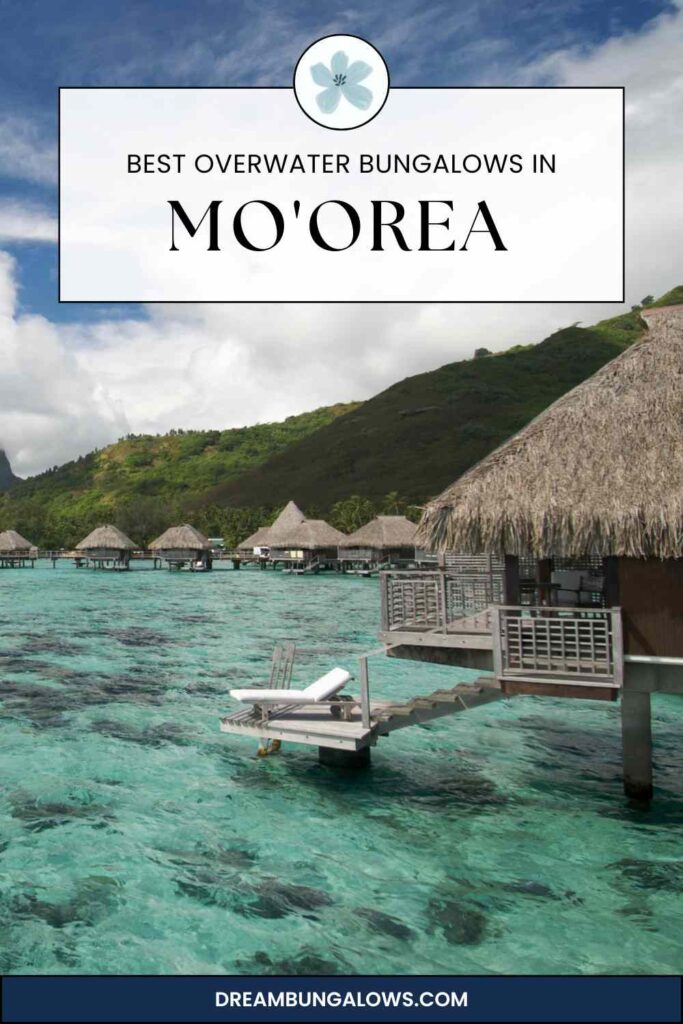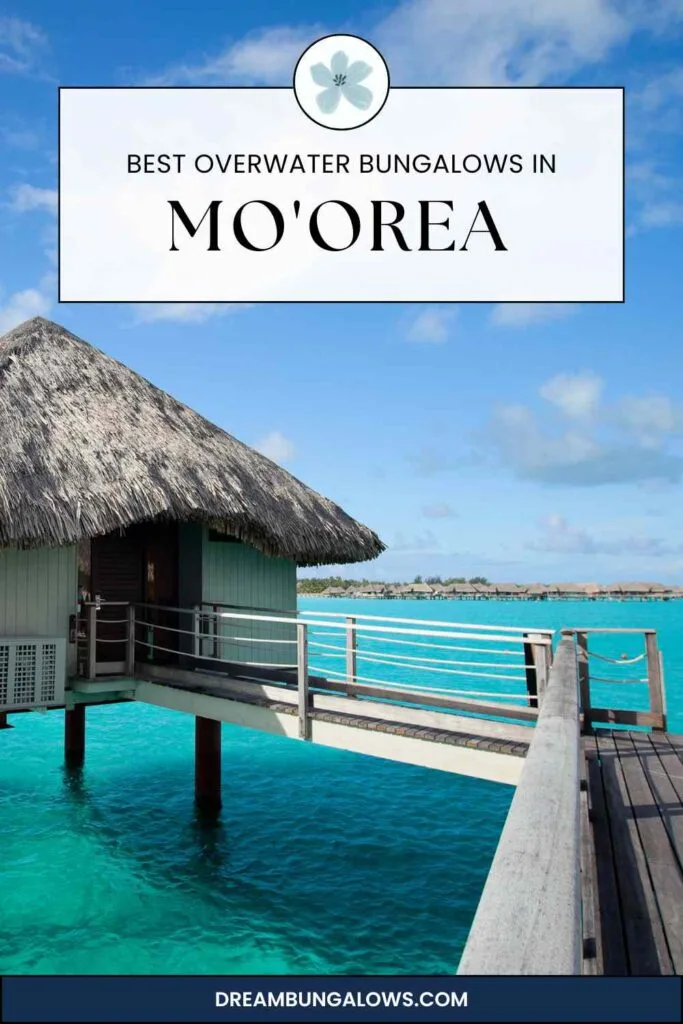When travelers think of French Polynesia, their minds often drift to Bora Bora’s skyline of thatched-roof villas perched over a dazzling lagoon.
Yet, right next door to Tahiti lies Mo’orea, an island many describe as one of the world’s best-kept secrets. A mere nine nautical miles from the bustle of Papeete, Mo’orea offers:
- Emerald, jagged peaks carved by ancient volcanoes
- A shimmering turquoise lagoon teeming with coral reefs
- Enchanting overwater bungalows, each with direct lagoon access
- An authentic island culture that merges modern comforts with warm Polynesian traditions
For those who want to indulge in an overwater escape without paying Bora Bora’s often higher rates—or simply crave a more laid-back vibe—Mo’orea fits the bill perfectly.
Understanding Mo’orea: Geography, Culture & Vibe
Geography & Layout
- Shape: Often likened to a heart or a butterfly, Mo’orea’s main landmass extends around two beautiful bays—Opunohu Bay and Cook’s Bay—which cut into the northern side.
- Mountains: Towering peaks such as Mount Rotui and Mount Tohivea create a dramatic backdrop visible from many vantage points (including from the deck of your overwater bungalow!).
- Ring Road: A single coastal road loops around the island, roughly 37 miles (60 km) in circumference, dotted with local shops, tiny eateries, and scenic lookout points.
Cultural Snapshot
- Population: Home to around 17,000 residents, Mo’orea fosters a small-town, welcoming feel.
- Language: French and Tahitian are most common; English is widely spoken in tourist areas.
- Economy: Tourism, agriculture, and artisanal crafts are key industries. Pineapple farming, in particular, is huge in Mo’orea—don’t miss the chance to sample fresh pineapple juices or visit the Rotui Juice Factory.
Overall Vibe
Mo’orea exudes a casual yet vibrant energy. It’s less glitzy than Bora Bora but more developed than smaller outer islands.
Think lively local events, family-run eateries, breezy beach hangouts, and plenty of opportunities to interact with genuine Polynesian culture.
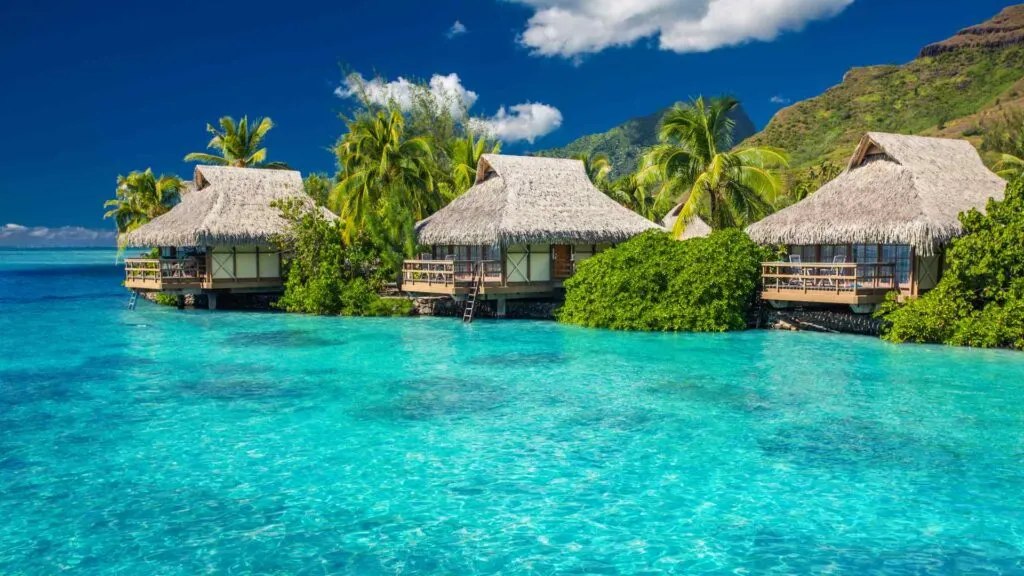
When to Visit: Seasons & Weather
French Polynesia enjoys a tropical climate with relatively consistent temperatures year-round, typically in the 77–86°F (25–30°C) range.
However, it does experience two primary seasons:
- Dry Season (May to October)
- Weather: Warm, lower humidity, fewer rain showers
- Popularity: High, as travelers flock for sunny skies and calm lagoons
- Rates: Can be higher due to demand; peak months (July & August) see surges in pricing
- Wet Season (November to April)
- Weather: Tropical downpours can occur, but often brief; warmer, more humid
- Crowds: Generally fewer tourists, so deals may be more plentiful
- Potential Downsides: More frequent showers, possible storms, though major cyclones are rare in French Polynesia
The shoulder months—April/May and October/November—often balance fair weather with somewhat lower rates, making them a sweet spot for many travelers.
Getting There: Flights & Ferry Transfers
Step 1: Fly into Tahiti (PPT)
- Most international flights to French Polynesia land at Faa’a International Airport in Papeete, Tahiti.
- Airlines like Air Tahiti Nui, Air France, Air New Zealand, and others provide direct or connecting routes from major hubs like Los Angeles, San Francisco, Paris, Tokyo, and Auckland.
Step 2: Hop to Mo’orea
- Ferry: The most popular route is a 30-40 minute ferry crossing from Papeete’s ferry terminal to Vaiare on Mo’orea. Ferries like Aremiti or Terevau operate several times a day, and the scenic ride offers your first taste of Polynesia’s blue waters.
- Short Flight: A quick 7–10 minute hop on a small plane from PPT to Mo’orea’s Temae Airport is another possibility—faster but typically more expensive than the ferry.
Step 3: Resort Transfer
- Most overwater resorts provide shuttles or private transfers from the ferry dock or airport. If you prefer flexibility, renting a car or scooter is straightforward—Mo’orea’s ring road is easy to navigate, and you’ll find additional scenic stops along the way.
Sit on the upper outdoor deck of the ferry for epic photo ops of Mo’orea’s mountainous silhouette as you approach.
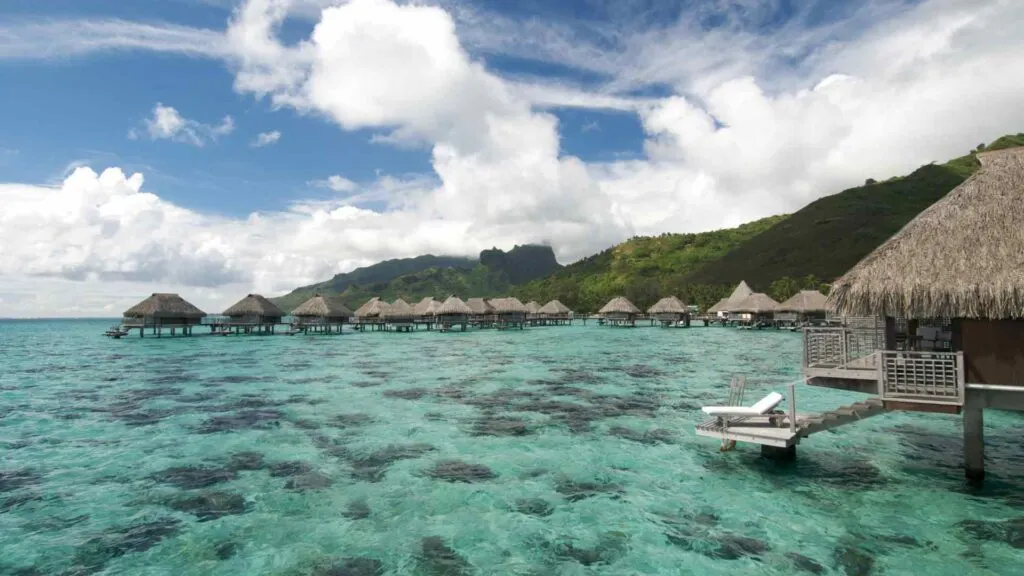
Overwater Bungalows in Mo’orea: The Essentials
Mo’orea is home to three operational resorts offering thatched-roof, stilted huts set above the lagoon:
- Hilton Moorea Lagoon Resort & Spa
- Sofitel Kia Ora Moorea Beach Resort
- Manava Beach Resort & Spa Moorea
Each property brings its own flavor of Polynesian design, water activities, and scenic vantage points.
Whether you want the largest bungalow on the island, a prime snorkeling spot, or the best beach, you’ll likely find your match among these.
Why Overwater Bungalows?
- Direct Lagoon Access: Climb down a ladder from your deck into crystal-clear water.
- Marine Life Viewing: Many bungalows feature glass panels or coffee tables to watch fish, rays, or even small sharks glide underneath.
- Romantic Ambiance: The sound of gentle waves lapping beneath your floor is an unbeatable lullaby.
- Bucket-List Experience: Overwater stays in French Polynesia rank among the world’s iconic travel experiences—Mo’orea keeps it dreamy yet relatively more accessible than Bora Bora.
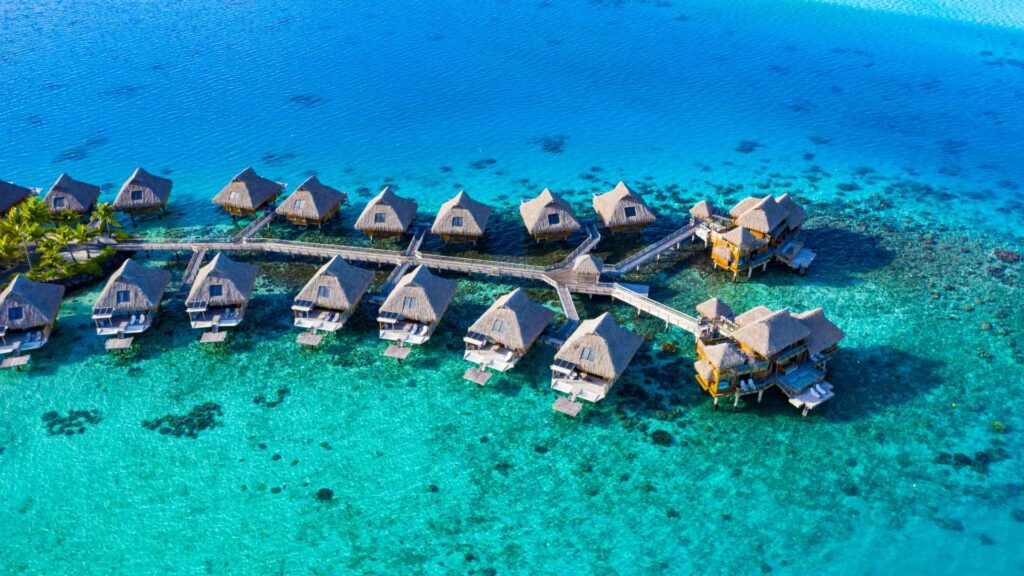
Mo’orea Overwater Resorts
Hilton Moorea Lagoon Resort & Spa
Estimated Price Range: $600 – $1,200 per night (overwater categories on the higher end)
Resort Overview
- Location: Between Cook’s Bay and Opunohu Bay on Mo’orea’s north shore, offering epic mountain backdrops.
- Bungalow Highlights:
- Many overwater units come with private plunge pools on the deck—perfect for an afternoon dip or stargazing soak.
- Glass floor panels for fish-watching from inside your bungalow.
- Resort Amenities:
- Overwater Crepe Bar: Watch reef sharks and stingrays patrol the water while savoring sweet or savory crepes.
- Spa & Fitness: Polynesian-inspired treatments using local ingredients; a modern fitness center for workout buffs.
- Water Activities: Snorkeling gear, kayaks, and paddleboards available. The lagoon right beneath the bungalows teems with colorful reef fish.
Dining & Culture
- Multiple on-site restaurants range from upscale Polynesian-French fusion to casual beachside dining.
- The resort often hosts Tahitian dance performances on special nights, letting guests experience authentic local music and choreography.
Who It’s Best For
- Couples & Honeymooners: The plunge-pool-equipped bungalows scream romance.
- Families: The Hilton brand usually extends a warm welcome to families, though note that overwater bungalows have direct lagoon access (supervision is key for younger kids).
- Snorkeling Enthusiasts: A lively coral garden is just steps away—or rather, ladders away—from your deck.
Sofitel Kia Ora Moorea Beach Resort
Estimated Price Range: $500 – $1,000 per night (overwater at the top end)
Resort Overview
- Location: Eastern side of Mo’orea near Temae Airport, affording spectacular views of Tahiti across the channel.
- Bungalow Highlights:
- Overwater bungalows often positioned for sunrise views, and you can watch Tahiti’s silhouette light up.
- Large decks with loungers, plus direct lagoon entry via stairs.
- Resort Amenities:
- Pristine Beachfront: A long, sandy stretch considered among Mo’orea’s best beaches. Perfect for sunbathing or casual swimming.
- Spa & Wellness: The on-site spa features Polynesian treatments, open-air relaxation areas, and lagoon-view treatment rooms.
- Water Sports: Complimentary snorkeling equipment, kayaks, and paddleboards to explore the lagoon’s crystal-blue shallows.
Dining & Culture
- K Restaurant: The resort’s signature dining venue, offering gourmet twists on local flavors.
- Beach Bar: Unwind with a cocktail at sunset while your toes sink into powdery sand.
- Polynesian Nights: Live music, Tahitian fire dances, and traditional buffets highlight the local culture.
Who It’s Best For
- Beach Lovers: The extensive beachfront is a standout.
- View Seekers: Wake up to uninterrupted vistas of Tahiti.
- Romantic Escapes: With quiet corners and a spa focusing on couples’ treatments, Sofitel is quite honeymoon-friendly.
Manava Beach Resort & Spa Moorea
Estimated Price Range: $400 – $900 per night (overwater on the upper range)
Resort Overview
- Location: Maharepa area on the northern coastline, near local shops, restaurants, and small boutiques.
- Bungalow Highlights:
- Overwater bungalows with direct lagoon access and often slightly shallower waters—great for novices to snorkeling.
- Some bungalows positioned near a coral garden that attracts a parade of reef fish.
- Resort Amenities:
- Infinity Pool: Overlooks the lagoon—ideal for mingling or a quick swim before dinner.
- On-Site Spa: Massages, facials, and other services use Tahitian oils and techniques.
- Family & Friendliness: The property has a more boutique feel, with a cozy ambiance that appeals to a broad range of travelers.
Dining & Culture
- Local Flair: The resort is a short walk from local snack bars and grocery spots in Maharepa, offering an easy taste of everyday Mo’orea life.
- Polynesian Shows: Expect themed nights, including coconut husking demos, dancing, and even cooking lessons.
Who It’s Best For
- Budget-Conscious Overwater Seekers: Manava often offers slightly lower rates for its stilted bungalows compared to Hilton or Sofitel.
- Travelers Wanting Convenience: Proximity to shops and restaurants lets you explore beyond resort dining.
- Families & Couples: More intimate vibe, suitable for both romantic getaways and group excursions.
Honorable Mention: InterContinental Moorea (Closed)
The InterContinental Moorea Resort & Spa was once a major player, featuring overwater suites and a dolphin center.
Currently, it remains closed indefinitely, with no official reopening date. If it ever reopens, it would again offer a prime lagoonfront location in northwest Mo’orea.
Check for announcements if planning far in the future—sometimes properties in French Polynesia do rebrand or refurbish and come back better than ever!
Comparing Mo’orea vs. Bora Bora Overwater Bungalows
Cost & Accessibility
- Mo’orea: A short ferry from Tahiti, plus generally lower nightly rates for overwater villas.
- Bora Bora: Requires a 45–50 minute flight from Tahiti, typically resulting in higher travel costs. Resort rates can be significantly steeper, often in the $1,000+ per night range for standard overwater categories.
Lagoon & Landscape
- Mo’orea: Known for lush, mountainous terrain, pineapple fields, local villages—perfect for combining lagoon fun with land-based adventures.
- Bora Bora: Famous for its iconic Mount Otemanu rising dramatically over a shallow, crystal-clear lagoon. The islets (motus) around the lagoon host many of the big-name resorts.
Atmosphere
- Mo’orea: Has a more laid-back, local vibe. You can rent a scooter, circle the entire island in a day, and stop at roadside fruit stands.
- Bora Bora: Tends to feel more high-end, with a heavier emphasis on honeymoon luxury. You might find yourself more “resort-bound,” with fewer easy local-exploration options.
Which to choose? If you want a slightly more casual vibe, easy ferry access from Tahiti, and the chance to explore local communities, Mo’orea is ideal.
For a super-luxe splurge with some of the world’s most famous lagoon views, Bora Bora fits the bill.
Mo’orea’s Must-Do Activities & Adventures
- Snorkel with Sharks & Rays: Join a lagoon tour for the chance to swim alongside blacktip reef sharks, stingrays, and a kaleidoscope of tropical fish.
- 4×4 Safari or ATV Tour: Venture into the lush interior—Opunohu Valley—for pineapple plantations, ancient marae (temples), and vantage points like Belvedere Lookout offering sweeping views of Cook’s and Opunohu Bays.
- Hiking: Trails range from gentle paths through fruit orchards to challenging mountain treks. Popular routes include the Three Coconuts Pass for epic valley panoramas.
- Dolphin & Whale Watching: From August to October, humpback whales migrate through Mo’orea’s waters. Specialized tours let you witness these gentle giants up close.
- Tiki Village Cultural Center: Immerse in Polynesian culture with dance shows, craft demonstrations, and an ahima’a (traditional underground oven feast).
- Jet Ski & Boat Tours: Circle the island’s coastline, stopping at sandbars or hidden coves for unforgettable snorkeling sessions.
- Pineapple Route: Explore local pineapple fields, taste fresh juices at the Rotui Juice Factory, or sample pineapple-infused rum.
- Cooking Classes: Some resorts or local chefs offer half-day courses on how to make poisson cru, banana poe (a sweet pudding), or breadfruit dishes.
Book popular activities—like dolphin swimming or whale-watching tours—in advance, especially in high season.
Local Culture & Cuisine
Culture
- Polynesian Hospitality: Warm greetings with a tiare flower, smiling faces, and a genuine desire to share local traditions.
- Sunday Family Day: In many Polynesian families, Sunday is dedicated to large family gatherings, hearty meals, and relaxation—expect quieter streets and shops.
- Music & Dance: Tahitian drums, ukuleles, and the vibrant ‘ote‘a dance are integral to local events and resort shows.
Cuisine
- Poisson Cru (Ia Ota): The national dish—fresh tuna marinated in lime juice and coconut milk, tossed with veggies like onion, tomato, or cucumber.
- Fruits & Juices: Pineapple, coconut, mango, papaya—Mo’orea’s fruit stands are legendary.
- Roulottes (Food Trucks): Around the island, these casual trucks serve everything from Chinese-Ma’a fusion to sweet crepes. Great for a budget-friendly meal.
- Fine Dining: Resorts and standalone restaurants serve French-Polynesian fusion, incorporating fresh seafood (mahi-mahi, parrotfish), local vanilla, and tropical fruits.
Try a pineapple-based cocktail like the “Mo’orea Colada” or get a fresh fruit smoothie at the roadside stands near Cook’s Bay for a mid-day treat.
Beyond Overwater: Other Accommodation Options
Not everyone can (or wants to) spend their entire trip in an overwater villa. Mo’orea has an array of alternative lodgings:
- Small Hotels & Guesthouses (Pensions): Examples include Pension Motu Iti, Hotel Kaveka, and Les Tipaniers, often with beach or lagoon views minus the stilted structure.
- Vacation Rentals & Villas: Perfect for families or larger groups. Platforms like Airbnb or VRBO list private homes or bungalows—some right on the beach.
- Camping & Eco-Lodges: A niche sector, but if you’re adventurous, you’ll find simple eco-retreats that highlight sustainable living and local experiences.
Split your stay—book a few nights overwater, then transition to a more affordable pension for the rest of your trip. You’ll still get that once-in-a-lifetime stilted experience without breaking the bank.
Sustainable Tourism & Environmental Care
French Polynesia takes pride in its spectacular marine ecosystems, and Mo’orea is no exception.
While overwater bungalows are incredible, they must be managed responsibly to protect coral reefs. Here’s how travelers can contribute:
- Reef-Safe Sunscreen: Chemical sunscreens with oxybenzone or octinoxate can harm coral. Opt for mineral-based sunscreens labeled “reef-safe.”
- Respect Marine Life: Don’t touch coral, chase fish, or stand on reefs. Keep a comfortable distance while snorkeling or diving.
- Conserve Water & Energy: Many islands rely on limited freshwater resources. Shorter showers, reusing towels, and turning off lights help reduce strain.
- Support Local Conservation Efforts: Some resorts partner with organizations planting coral or rehabilitating sea turtles. Ask how you can participate or donate.
- Responsible Dolphin & Whale Tours: Choose accredited operators who follow guidelines ensuring minimal disturbance to marine mammals.
By being a conscious traveler, you help preserve Mo’orea’s pristine waters and breathtaking biodiversity for future visitors and local communities.
FAQ: Your Mo’orea Overwater Questions Answered
1. When’s the best time to visit Mo’orea for overwater stays?
- Dry Season (May–October): Sunniest weather, calm lagoons, higher demand, and rates.
- Wet Season (November–April): Warmer, more humid, fewer crowds, potential for storms. Shoulder months like April/May and October/November can offer a sweet spot of decent weather and slightly lower prices.
2. How long should I stay in an overwater bungalow?
3–5 nights is typical for many travelers. Some stay a full week for maximum relaxation.
If you’re on a budget or island-hopping, consider a split stay—2–3 nights overwater, then shift to another accommodation type.
3. Is Mo’orea cheaper than Bora Bora?
Generally, yes. Mo’orea overwater rates often fall below Bora Bora’s sky-high brackets, and you save on short ferry rides versus a more expensive flight to Bora Bora.
4. Are overwater bungalows kid-friendly?
Many are, though direct lagoon access can be a safety concern for very young kids.
Resorts like Hilton Moorea and Manava do welcome families—just ensure the bungalows have proper railings, and always supervise children around water.
5. Do I need a visa for French Polynesia?
Most visitors (from the U.S., Canada, EU, etc.) receive a 90-day entry permit on arrival with a valid passport and proof of onward travel.
Always confirm up-to-date requirements before your trip.
6. Which currency is used on Mo’orea?
The CFP franc (XPF) is the official currency in French Polynesia. Major hotels and restaurants accept credit cards, and ATMs exist near Maharepa.
Some smaller establishments may accept euros or U.S. dollars, but the exchange rate may not be ideal.
7. What language is spoken?
French and Tahitian are official languages. English is common in resorts and tourist areas, but learning basic French or Tahitian greetings can enhance your cultural experience.
8. How do I get around the island?
- Car or Scooter Rental: A popular choice for exploring at your own pace.
- Taxis: Available but pricier.
- Le Truck Buses: Limited service around the island; check schedules locally.
9. Is Wi-Fi reliable?
Resorts usually offer complimentary Wi-Fi—though speeds can vary. Local cafes and some pensions also provide connectivity, but remote areas might have slower or spottier signals.
10. Can I snorkel directly off the bungalow?
Absolutely! One of the top perks is stepping from your deck into the lagoon. Resorts often mark safe areas around the bungalows, with corals and fish ready to greet you.
Conclusion & Final Tips
From the moment you step off the ferry and see Mo’orea’s soaring green peaks, you’ll realize this is no ordinary tropical island.
Mo’orea weaves together cultural authenticity, jaw-dropping natural landscapes, and the bucket-list wonder of overwater bungalows—all with an approachable charm that keeps travelers returning again and again.
Final Packing Checklist:
- Reef-Safe Sunscreen & Insect Repellent – Protect your skin and the marine environment.
- Swimwear & Lightweight Clothing – The climate is tropical; stay cool.
- Snorkel Gear (Optional) – Resorts provide some, but bringing a personal set ensures a perfect fit.
- Reputable Water Shoes – Coral can be sharp; if you plan to wade around shallow reefs, keep your feet safe.
- Camera or GoPro – Capture lagoon life under your bungalow and the island’s dramatic vistas.
- Travel Adaptors – French Polynesia uses Type E/F plugs (European style).
- A Sense of Adventure – Embrace everything from pineapple farm visits to shark-ridden snorkel trips.
Mauruuru (thank you) for exploring Mo’orea’s overwater bungalow scene with us.
Whether you’re savoring a romantic dinner on your stilted deck, snorkeling alongside reef sharks, or riding a scooter through pineapple fields, you’ll find that Mo’orea offers a warm, welcoming take on South Pacific paradise—equal parts thrill, relaxation, and heartfelt Polynesian hospitality.
Safe travels, and may your days in Mo’orea be filled with gentle lagoon breezes, mesmerizing sunsets over the water, and a deep connection to the island’s lush landscape and vibrant culture. Ia ora na (good life) from Mo’orea!
